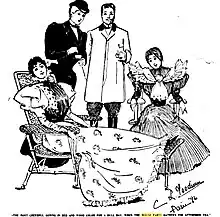House party
A house party is a type of party where people gather at the residence of the party's host.



Organization
A house party might be organized several months or just a few hours in advance. News of a party may be spread by personal invitations, word of mouth, posted leaflets, or notices on social networking sites. Broad notice of a party – sometimes unintentionally – can result in large numbers of people attending who do not know the host personally, and may be disruptive. A person who attends a house party but has not been invited, is typically referred to as a "gatecrasher", particularly if the party is open only to invited guests; they are usually perceived negatively, but may nonetheless be welcomed by the host.
History
An early example of a house party can be seen in the play Mostellaria (The Haunted House) by the Roman playwright Plautus. In the play, a young man called Philolaches holds a house party with many friends while his father Theopropides is away on business.[1]
House parties have become a prominent feature in popular movies, particularly movies aimed at teenagers. While many have probably been present before the movie, The Party is one of the first to properly provide a scene of a house party.[2] However, the most popular film later on is House Party featuring hip hop duo Kid 'n Play.
In various cultures
In the former Yugoslavia, a sijelo (In Ijekavian), silo (In Ikavian) or selo (In Ekavian) is an evening social gathering at a house. The use of the word sijelo is particularly widespread in Bosnia and Herzegovina.
In Ireland, a Céilí is a social gathering which, in its traditional form, takes place in a domestic dwelling. Contemporary céliís often involve music and dancing and can also take place in a public or private meeting space, in addition to in a domestic setting.
In the United Kingdom, house parties may be referred to as a 'Skins' party, referring to a well-known TV show focusing on the lives of teenagers who often participate in and host open house parties.[3][4][5]
See also
References
- "Review: The Troubies turn an ancient Roman comedy into a modern ‘Haunted House Party’" by Charles McNulty at www.latimes.com
- "The ideal cause for cerebration: Kevin Jackson sees in the new year by crashing some memorable parties on film and in print" by Kevin Jackson at www.independent.co.uk
- "‘I was there’ – remembering Foals’ secret ‘Skins’ party" by Leonie Cooper at www.nme.com
- "Teen spirit: The 'Skins' sensation sweeping France" by Holly Williams at www.independent.co.uk
- "Remembering the British Teenage Phenomenon of 'Skins Parties'" by Hannah Ewens at www.vice.com
Bibliography
For Sijelo:
- Milenko S. Filipović (1982). Among the people, native Yugoslav ethnography: selected writing of Milenko S. Filipović. Michigan Slavic Publications, Dept. of Slavic Languages and Literatures. p. 97. ISBN 9780930042479.
- Norman M. Naimark; Holly Case (2003). Yugoslavia and Its Historians: Understanding the Balkan Wars of the 1990s. Stanford University Press. ISBN 978-0-8047-4594-9.